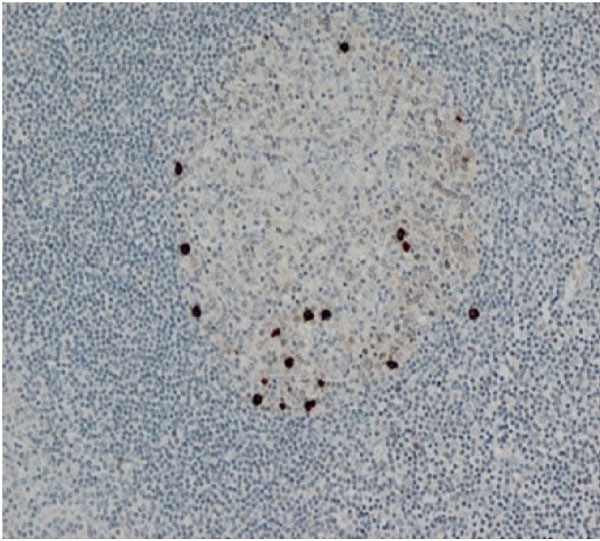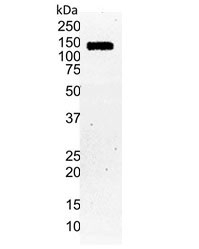HIF1 Alpha antibody | Halpha111a


Mouse anti Human HIF1 Alpha
- Product Type
- Monoclonal Antibody
- Clone
- Halpha111a
- Isotype
- IgG2a
- Specificity
- HIF1 Alpha
| Mouse anti Human HIF1 alpha antibody, clone Halpha111a recognizes human Hypoxia-inducible factor 1-alpha otherwise known as HIF1 alpha (HIF1A) or ARNT interacting protein, a widely expressed bHLH-PAS transcription factor, which acts as a critical regulatory protein in the host response to hypoxia (Kubis et al. 2005). HIF1A and HIF1B, also known as ARNT form the highly-conserved heterodimeric HIF-1 transcriptional complex (Carmeliet et al. 1998). During hypoxic conditions, HIF1A accumulates in the nucleus and activates the transcription of many genes encoding proteins involved in the production of oxygen delivery and metabolic adaptation, such as those for vascular endothelial growth factor (VEGFA) . Under normal oxygen conditions, HIF1A is targeted by hypoxia inducible factor prolyl-hydroxylases, followed by rapid protease degradation, which is inhibited during hypoxia (Hirsilä et al. 2003). Overexpression of HIF1A occurs in many common human cancers, including pancreatic, bladder and renal carcinomas (Shibaji et al. 2003). Mouse anti Human HIF1α, clone Halpha111a has been successfully used for the identifcation of HIF1α in human samples by both immunohistochemistry and western blotting. |
- Target Species
- Human
- Product Form
- Purified IgG - liquid
- Preparation
- Purified IgG prepared by affinity chromatography on Protein A from tissue culture supernatant
- Buffer Solution
- Phosphate buffered saline
- Preservative Stabilisers
- 0.09% Sodium Azide (NaN3)
- Carrier Free
- Yes
- Immunogen
- Recombinant human HIF1 alpha.
- Approx. Protein Concentrations
- IgG concentration 1.0 mg/ml
- Regulatory
- For research purposes only
- Guarantee
- 12 months from date of despatch
Avoid repeated freezing and thawing as this may denature the antibody. Storage in frost-free freezers is not recommended.
| Application Name | Verified | Min Dilution | Max Dilution |
|---|---|---|---|
| Immunohistology - Paraffin 1 | 1/25 | ||
| Western Blotting |
- 1This product requires antigen retrieval using heat treatment prior to staining of paraffin sections.
EDTA pH9.0 is recommended for this purpose.
- Histology Positive Control Tissue
- Human tonsil
Further Reading
-
Semenza, G.L. (2000) HIF-1 and human disease: one highly involved factor.
Genes Dev. 14 (16): 1983-91.
- Synonyms
- HYPOXIA-INDUCIBLE Factor 1-alpha
- RRID
- AB_10671910
- UniProt
- Q16665
- Entrez Gene
- HIF1A
- GO Terms
- GO:0001666 response to hypoxia
- GO:0001837 epithelial to mesenchymal transition
- GO:0001938 positive regulation of endothelial cell proliferation
- GO:0002248 connective tissue replacement involved in inflammatory response wound healing
- GO:0003677 DNA binding
- GO:0003705 sequence-specific enhancer binding RNA polymerase II transcription factor activity
- GO:0004871 signal transducer activity
- GO:0005737 cytoplasm
- GO:0005667 transcription factor complex
- View More GO Terms
- GO:0005730 nucleolus
- GO:0008134 transcription factor binding
- GO:0051879 Hsp90 protein binding
- GO:0010575 positive regulation vascular endothelial growth factor production
- GO:0010634 positive regulation of epithelial cell migration
- GO:0046886 positive regulation of hormone biosynthetic process
- GO:0030528 transcription regulator activity
- GO:0030949 positive regulation of vascular endothelial growth factor receptor signaling pathway
- GO:0032364 oxygen homeostasis
- GO:0032722 positive regulation of chemokine production
- GO:0032909 regulation of transforming growth factor-beta2 production
- GO:0032963 collagen metabolic process
- GO:0035035 histone acetyltransferase binding
- GO:0042789 mRNA transcription from RNA polymerase II promoter
- GO:0043193 positive regulation of gene-specific transcription
- GO:0043619 regulation of transcription from RNA polymerase II promoter in response to oxidative stress
- GO:0045648 positive regulation of erythrocyte differentiation
- GO:0045766 positive regulation of angiogenesis
- GO:0045821 positive regulation of glycolysis
- GO:0045944 positive regulation of transcription from RNA polymerase II promoter
- GO:0046982 protein heterodimerization activity
- GO:0051000 positive regulation of nitric-oxide synthase activity
- GO:0051541 elastin metabolic process
MCA5644
If you cannot find the batch/lot you are looking for please contact our technical support team for assistance.
Please Note: All Products are "FOR RESEARCH PURPOSES ONLY"
View all Anti-Human ProductsAlways be the first to know.
When we launch new products and resources to help you achieve more in the lab.
Yes, sign me up
